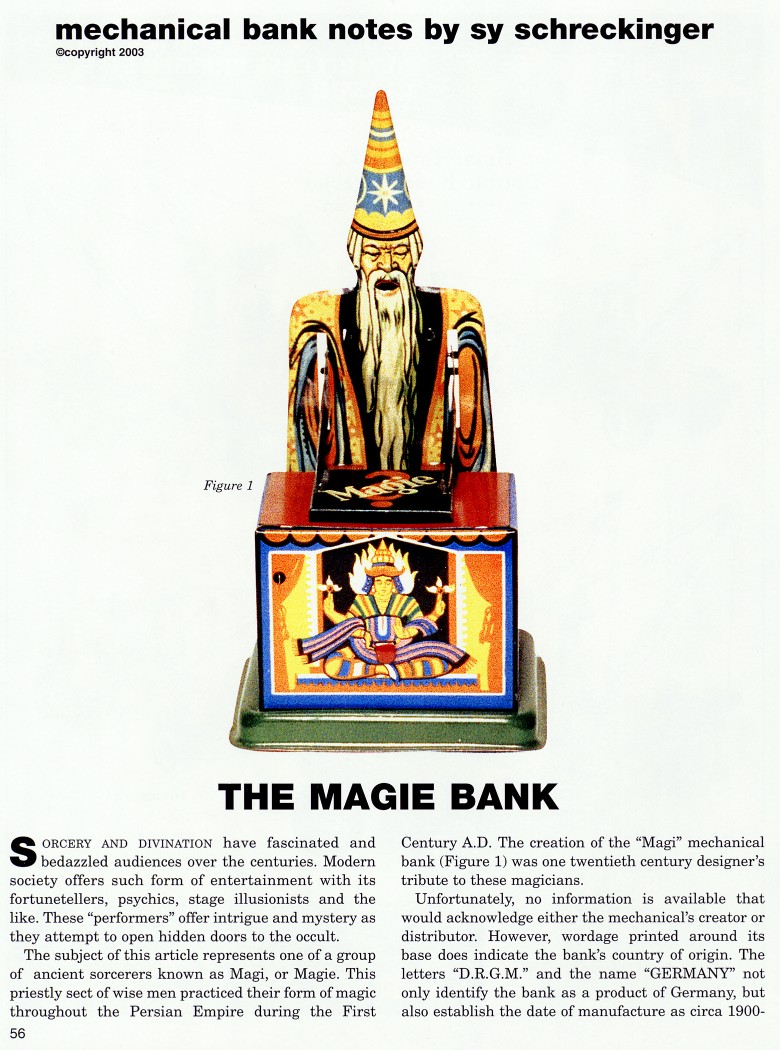|
The Magie Bank
by Sy Schreckinger – ANTIQUE TOY WORLD Magazine – June, 2003
Sorcery and divination have fascinated and
bedazzled audiences over the centuries. Modern society offers such form of
entertainment with its fortunetellers, psychics, stage illusionists and
the like. These "performers" offer intrigue and mystery as they attempt to
open hidden doors to the occult.
The subject of this article represents one of a group of ancient
sorcerers known as Magi, or Magie. This priestly sect of wise men
practiced their form of magic throughout the Persian Empire during the
First Century A.D. The creation of the "Magi" mechanical bank (Figure 1)
was one twentieth century designer's tribute to these magicians.
Unfortunately, no information is available that would acknowledge
either the mechanical's creator or distributor. However, wordage printed
around its base does indicate the bank's country of origin. The letters "D.R.G.M."
and the name "GERMANY" not only identify the bank as a product of Germany,
but also establish the date of manufacture as circa 1900-1935. During this
time period, manufactured goods considered by the German Patent Office to
be "unimportant" were imprinted with the letters "D.R.G.M." ("Deutsches
Reichs Gebrach Musters"). Such documents were government mandated to be
routinely destroyed after fifteen years, thus relegating these "frivolous"
goods, particularly toys, to an obscure heritage. As with so many other
survivors of that era, it is hoped that a catalog or advertising flyer
might surface which would provide much needed historical data.
The "Magie" is one of a group of mechanicals produced both here and
abroad that specifically features the illusion of the "disappearing coin".
Other notables comprising this provocative family include: "Magician Bank"
(Antique Toy World, February 1985), "Presto Trick Drawer Bank" (A.T.W.,
April 1992), "Freedman's Bureau" (A.T.W.,
June 1997), "Chandler's Bank",
Clark's "Child's Bank", "Serrill's Bureau", several "Trick Drawer" money
boxes, etc.
It is interesting that the designer/manufacturer of the "Magie Bank"
attempted to incorporate an element of historical and regional
authenticity into their creation. Note the Middle Eastern/Persian motif
decorating the front and side panels of the Magie's table. Such subtle yet
attractive touches, so reminiscent of most early German tin mechanicals,
add greatly to the bank's desirability.
The "Magie Bank" is considered quite scarce. Fortunate is the
collector able to add a fine, all original example to his/her collection.
Action of the "Magie Bank" is interesting and appropriate to the
subject. A coin is placed within the circular depression on the top of the
table (Figure 2). The lever behind the "Magie" is pressed downward. This
causes the arms and hands holding the square cover to lower, thus hiding
the coin from sight (Figure 1). When the lever is released, the arms rise
upward, lifting the cover and, presto, the coin has disappeared! Deposits
are recovered by opening the key lock, trap door type coin retainer
located underneath the base.
In Figure 3 is seen the front, back, and both sides of an original
cardboard box which housed a "Magie Bank" when it was initially offered
for sale. It, too, can offer no information since it lacks identifying
marks that might have furnished evidence of the bank's manufacture, etc.
Dimensions of the "Magie Bank" are as follows: Height from base to
top of hat: 6-7/8 inches; Width of base: 3-1/16 inches. To my knowledge
this mechanical has not been reproduced. These measurements are provided
solely to aid the collector in determining size and scale.
Acknowledgement: The mint example "Magic Bank" seen in Figure 1 and
its cardboard box, Figure 3, are in the collection of Steve and Marilyn
Steckbeck.
|


